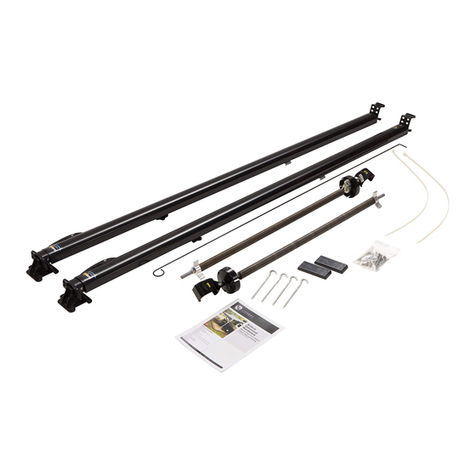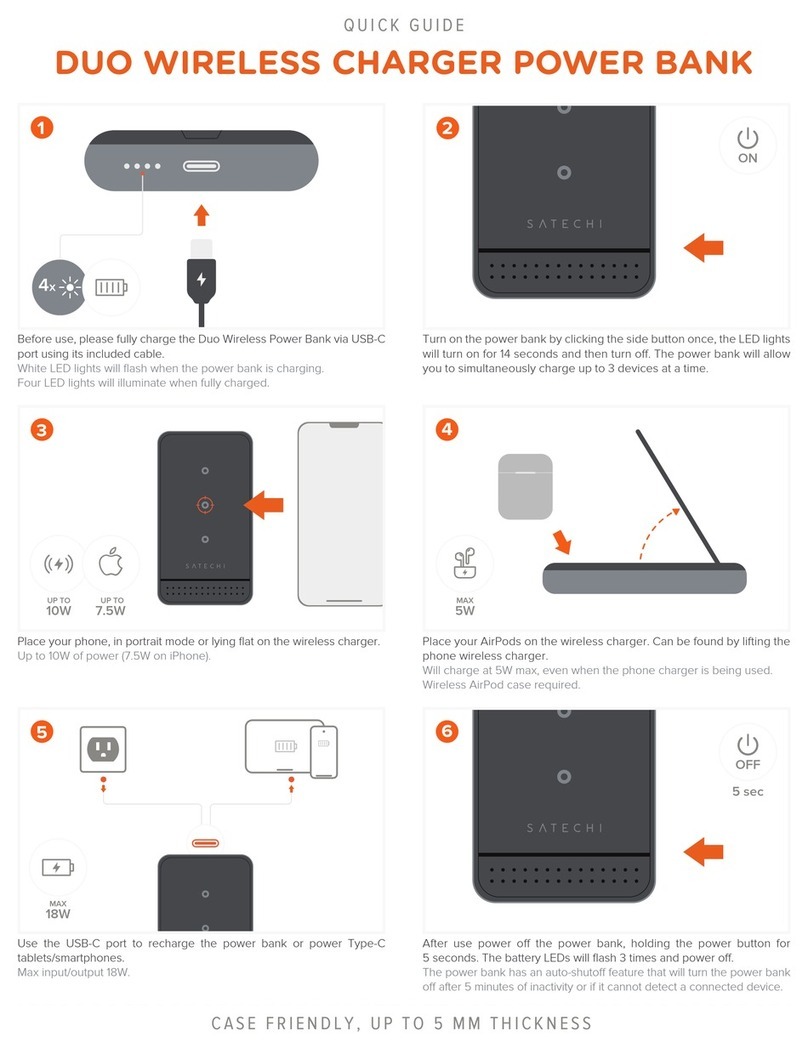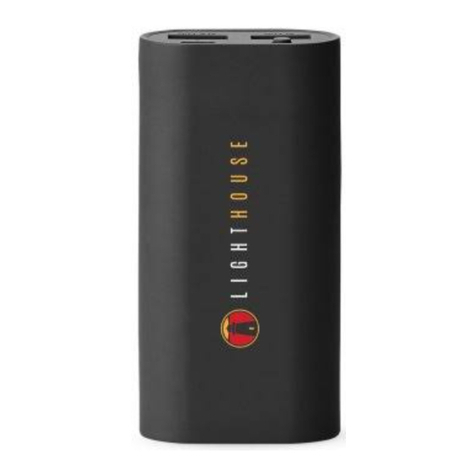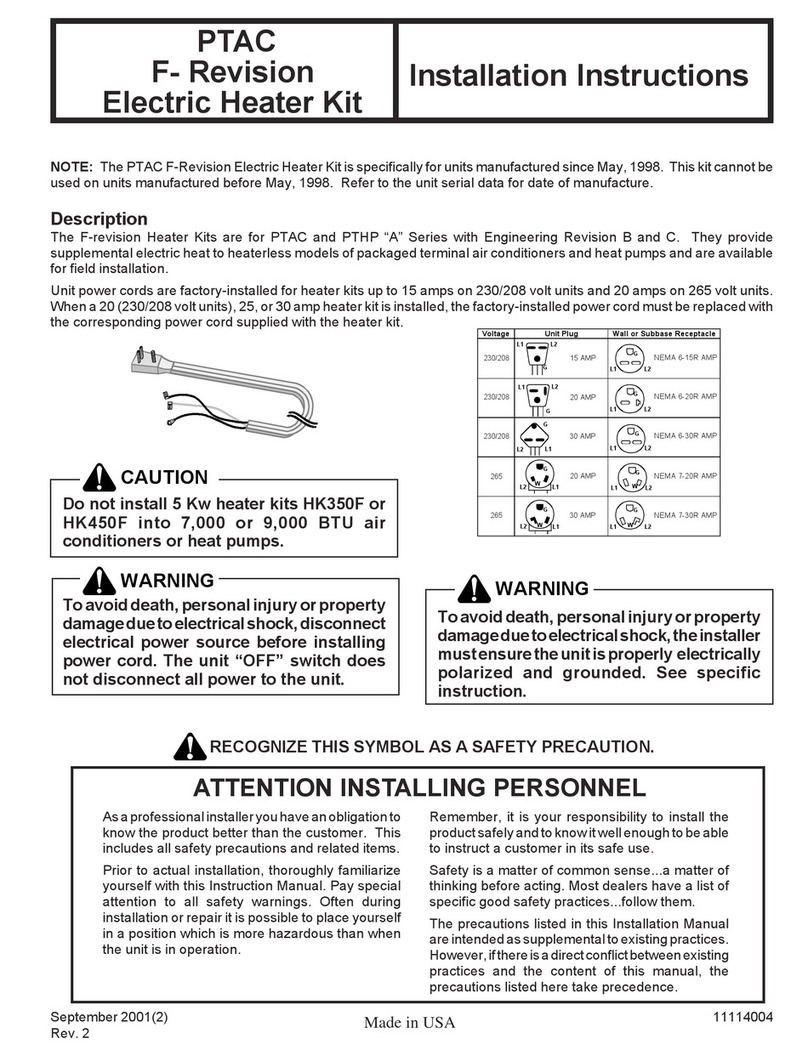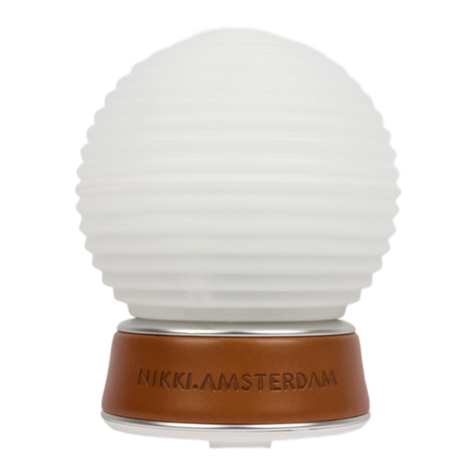Metway CRBMWDD3 User manual

page 12
LOAD
Channel 1 (switching):
10A of lighting and or ventilation including incandescent, fluorescent, compact fluorescent, low voltage
(switch primary of transformer).
Channel 2 (dimming):
Maximum number of DSI or DALI ballasts is 10 unless the relay is disabled then it is 20.
SUPPLY VOLTAGE 220-240 Volts AC 50 Hz
TIME OUT PERIOD Adjustable 10 seconds to 99 minutes
LIGHT LEVEL Light to dark
TERMINAL CAPACITY 2.5mm2
MATERIAL Flame retardant ABS
TYPE Class 2
TEMPERATURE -10°C to 35°C
SAFETY The microwave radiation emitted by these units is exteremely low power.
At a distance of > 50mm the power density is <6% of the ANSI IEEE C95.1 –1991
recommended microwave power density.
At a distance of 5mm from the unit it is <84% of recommended power density.
CONFORMITY EMC-89/336/EEC
LVD-73/23/EEC
13. Specification
Ref #WD417 Issue 1
IMPORTANT NOTICE!
This device should be installed by a qualified electrician in
accordance with the latest edition of the IEE wiring regulations.
Due to our policy of continual product improvement Metway Electrical Industries
reserves the right to alter the specification of this product without prior notice.
Metway Electrical Industries Limited
Barrie House
18 North Street
Portslade
East Sussex
BN41 1DG
Tel: + 44 1273 439266
Fax: + 44 1273 439288
www.metway.co.uk
page
1. Dimensions
Section Contents Page
1 Dimensional information 1
2 Description and operation 2
3 Wiring & Fixing 3
4 Installation 3
5 Fixing - Flush 4
6 Fixing - Surface 4
7 Head locking 5
8 Time, Lux & Sensitivity adjusters 5
9 Programming 6
10 Wiring diagrams 8
11 Detection pattern diagrams 11
12 Fault finding 12
13 Specification 12
14 Part numbers 12
Contents
Direct Dim Microwave Presence/Absence Detector
Product Guide
CRBMWDD3

page 2
The CRBMWDD3 microwave presence detector provides automatic control of lighting loads with optional
manual control. It can be used on incandescent, fluorescent and compact fluorescent lighting and DSI or
DALI digital dimming ballasts over 1 or 2 channels. The CRBMWDD3 detects movement using a highly
sensitive microwave detector. This works by emitting low power microwave signals and measuring the
reflections as the signals bounce off moving objects. The CRBMWDD3 has a unique adjustable sensor
head that allows the area of detection to be optimised for the application.
The dimming channel of the detector can be used to control the light output of luminaires that are fitted
with dimming ballasts. The detector measures the overall light level in the detection area and calculates
the correct output for the luminaires, to achieve a preset lux level (maintained illuminance).
The switching channel of the detector can either be used to isolate the supply to the dimming ballasts
(saving on the standby current of the ballasts) or to switch a separate channel of standard, non-dimming
luminaires.
Two input terminals can be used to manually override the dimming levels and override the lights on or off.
The flexibility of having two channels and two switch inputs allows the following example scenarios:
1. Dim an outside row of luminaires whilst internal fittings are switched
2. Provide absence detection (see below) for two separate channels
3. Maintained illuminance system with manual up/down controls
An integral infra-red sensor in the unit allows the unit to be programmed using the optional CRPHS
programming handset. This gives complete flexibility over many of the operating parameters. Without the
handset, manual adjustments can be made to the sensitivity, lux and time settings using controls
accessible behind the lens.
The UHS user handset can be used to change output lux levels and override the lights on or off.
Two standard units are available:
CRBMWDD3 - presence detection:
When movement is detected the load will automatically turn on. When the area is no longer occupied the
load will automatically switch off after an adjustable time period.
CRBMWDD3/ABS - absence detection:
The load is manually switched on. When the area is no longer occupied the load will automatically switch
off after the adjustable time period has elapsed. Note that the CRBMWDD3 can be programmed to
absence detection using the programming handset.
In most applications the CRBMWDD3 can be used with simple manual adjustment. However, the
CRBMWDD3 unit has a comprehensive set of features that can be set using the CRPHS handset.
Alternatively the units can be commissioned as follows:
On-site commissioning service - please contact our sales department for details.
Pre-commissioning service - the units will be despatched to site with the correct features set. The
part number will read CRBMWDD3/PRG followed by the project reference number. Please contact
our sales department for details.
2. Description and Operation
page 11
11. Detection Patterns
Ideal for large office or classroom
Ideal for corridor or aisle applications
Ideal for open plan areas and offices
LOAD DOES NOT COME ON
Check to see if the live supply to the circuit is
good. Strap across the L and LIVE OUT terminal
to turn the load on.
If the supply and wiring are good, check the LUX
level setting. Increase the LUX level setting to
allow the controller to turn on at higher ambient
natural light level.
LIGHTS DO NOT GO OFF
Ensure that the area is left unoccupied for a
greater time period than the time out period set
using the switch.
Make sure that the sensor is not adjacent to
vibrating surfaces or objects (e.g. ventilation
equipment).
The unit may pick up movement through thin
partitions or walls. Reduce the sensitivity by
turning the adjuster anticlockwise.
12. Fault Finding

page 10
10.4 Single channel switching
Functions: Switches channel 1 only with occupancy, optional override switch. No dimming output.
Configured to presence detection: Turns on automatically with occupancy. Press and release down
switch to turn off. Press and release up switch to turn back on. Turns off after occupancy.
Configured to absence detection: Press and release up switch to turn on. Press and release down
switch to turn off. Turns off after occupancy.
Channel mode: Set to ―Switch only‖
Switch mode: Set to ―2 position switch together‖. Note: a single position switch can be used instead to
toggle the output, set to ―1 position switch separate‖.
10.3 Two channel, common switch (continued)
L/OUT
L
N
EBDSPIR-DD SENSOR
SW1/UP
SW2
DOWN
CIRCUIT PROTECTION
(IF REQUIRED)
LIVE
NEUTRAL
CENTRE BIASED
RETRACTIVE SWITCH
(240V SWITCHING)
Optional for presence,
mandatory for absence detection
LUMINAIRE
(NON-DIMMING)
DIM+
DIM-
PLEASE NOTE THAT THE CENTRE BIASED RETRACTIVE
SWITCH WILL PROVIDE CONTROL FOR THE DIMMING
LUMAIRE(S) ONLY. THE NON-DIMMING LUMINAIRE(S) WILL
BE CONTROLLED ONLY BY THE SENSOR
L/OUT
L
N
EBDSPIR-DD SENSOR
SW1/UP
SW2
DOWN
PLEASE NOTE THAT THE
DIMMING SIGNAL IS USED TO
SWITCH THE DIMMING
LUMINAIRE ON/OFF AND
THEREFORE THE 240V FEED
TO THE LUMINAIRE FITTING
MUST COME FROM THE
PERMANENT LIVE SUPPLY
DIMMING
BALLAST
DIMMING LUMINAIRE
(DSI or DALI)
LUMINAIRE
(NON-DIMMING)
CIRCUIT PROTECTION
(IF REQUIRED)
LIVE
NEUTRAL
CENTRE BIASED
RETRACTIVE SWITCH
(240V SWITCHING)
Optional for presence,
mandatory for absence detection
DIM+
DIM-
CRBMWDD3 SENSOR
CRBMWDD3 SENSOR
page 3
3. Wiring & Fixing
Wire the products using the diagrams shown in section 10.
To switch from more than one position simply wire two or more units in parallel using the Live,
Neutral, Switched Live and manual switch wires only. The dimming connection must be wired to
one unit only.
The detector should be sited so that the occupants of the room fall inside the detection pattern
shown in section 11.
Corridors or aisles: the unit should be placed at the end of the corridor or aisle and the sensor
head should be angled to look down the corridor or aisle.
Open plan areas and offices: the unit can be mounted in a corner looking outwards in which
case the sensor head should be angled, or the unit can be mounted in the centre of the area
with the sensor head flat.
Note that the higher the sensor is installed the shorter the detection range will be.
Sites as far away as possible from any lighting or ventilation equipment.
Do not fix to a vibrating surface.
Do not fix to a suspended luminaire.
Site as far away as possible from the surface of metal objects.
Mount using one of the two options overleaf.
1. Make sure the load is connected and in working order.
2. Isolate the mains supply to the circuit at the main consumer unit.
3. Connect the sensor via the terminal blocks. Live supply to the Lterminal; load to the L/OUT
terminal; Neutral to the N terminal on the green terminal block. Dimming / external connections
should be made as required according to the applicable wiring diagrams shown in section 10.
4. Use a small screwdriver to set the LUX level adjuster fully clockwise, the time to minimum (fully
anticlockwise) and the sensitivity to maximum (fully clockwise) using the diagram in section 8.
5. Apply power—the load should come on immediately.
6. Vacate the room or remain very still and wait for the load to switch off (should take no more than 2
minutes).
Check that the load switches on when movement is detected.
7. For dimming applications, set the light output level by using the LUX adjustment thumbwheel or
the handset. See section 9 for handset operation.
During operation the output level varies very gradually. However when the LUX level is
changed the unit automatically enters setup mode: in this mode the output level varies
rapidly. After the setup time the unit reverts to normal.
When adjusting the output, allow the output level to settle by changing very gradually.
To disable the maintained illuminance function completely, set the LUX level to maximum
9. Select the time out range using the adjuster, fully clockwise is the maximum.
10. The area of detection can be varied by altering the angle of the sensor head and the sensitivity
adjuster. Note: on maximum sensitivity this unit is extremely sensitive to movement and may
detect through glass, thin walls or partitions. If this causes a problem reduce the sensitivity by
turning the adjuster anticlockwise.
11. Using the UHS or UHS3 infra-red handset: the override on button turns the unit on permanently;
the override off button turns the unit off permanently; the cancel button cancels the overrides.
When an override is selected an LED will flash inside the unit. The UHS handset can also be used
to set the lux levels—see Section 9.5
Note: the above adjustments can also be made using the CRPHS handset instead of the
manual
4 Installation

page 4
Warning - be careful bending springs when mounting unit.
Warning - be careful bending springs when mounting unit.
5. Fixing - Flush
6. Fixing - Surface
1 32
4
1 432
Hole Ø74mm
Hole Ø30mm MAX
50mm or 60mm
fixing centres
Attach cable clamp.
page 9
10.2 Two channel, individual switches
Functions: Switches both channels with occupancy. Maintains illuminance, dims and switches the
dimming channel using optional single position retractive switch (switch 2). Switches the switching channel
using the optional single position retractive switch (switch 1).
Configured to presence detection: Turns on automatically with occupancy. Maintains illuminance
(dimming channel only). Press and release switch to toggle output. Press and hold switch to dim up and
down (reverses direction with each press). Turns off after occupancy.
Configured to absence detection: Press and release switch to turn on. Maintains illuminance (dimming
channel only). Press and release switch to turn off. Press and hold switch to dim up and down (reverses
direction with each press). Turns off after occupancy.
Channel mode: Set to ―Switch and dim separate‖
Switch mode: Set to ―1 position switch separate‖
-
+
10.3 Two channel, common switch
Functions: Switches both channels with occupancy. Maintains illuminance, dims and switches the
dimming channel using optional centre biased retractive switch .
Configured to presence detection: Turns on automatically with occupancy. Maintains illuminance
(dimming channel only). Press and release down switch to turn off. Press and release up switch to turn
back on. Press and hold up switch to dim up, press and hold down switch to dim down. Turns off after
occupancy. Channel 1 does not operate with switch.
Configured to absence detection: Press and release up switch to turn on. Maintains illuminance
(dimming channel only). Press and release down switch to turn off. Press and hold up switch to dim up,
press and hold down switch to dim down. Turns off after occupancy. Channel 1 does not operate with
switch.
Channel mode: Set to ―Switch and dim separate‖
Switch mode: Set to ―2 position switch separate‖
L/OUT
L
N
EBDSPIR-DD SENSOR
SW1/UP
SW2
DOWN
PLEASE NOTE THAT THE
DIMMING SIGNAL IS USED TO
SWITCH THE DIMMING
LUMINAIRE ON/OFF AND
THEREFORE THE 240V FEED
TO THE LUMINAIRE FITTING
MUST COME FROM THE
PERMANENT LIVE SUPPLY
SWITCH 1 - MOMENTARY
PUSH TO MAKE SWITCH
(240V SWITCHING)
Optional for presence,
mandatory for absence detection
SWITCH 2 - MOMENTARY
PUSH TO MAKE SWITCH
(240V SWITCHING)
Optional for presence,
mandatory for absence detection
DIMMING
BALLAST
DIMMING LUMINAIRE
(DSI or DALI)
LUMINAIRE
(NON-DIMMING)
CIRCUIT PROTECTION
(IF REQUIRED)
LIVE
NEUTRAL
DIM+
DIM-
CRBMWDD3 SENSOR

page 8
10. Wiring Diagrams
6.1 Single channel dimming
Functions: Switches the luminaire with occupancy and maintains illuminance. Dims and switches using
optional centre biased retractive switch (MK K4900 or similar).
Configured to presence detection: Turns on automatically with occupancy. Maintains illuminance.
Press and release down switch to turn off. Press and release up switch to turn back on. Press and hold up
switch to dim up, press and hold down switch to dim down. Turns off after occupancy.
Configured to absence detection: Press and release up switch to turn on. Maintains illuminance. Press
and release down switch to turn off. Press and hold up switch to dim up, press and hold down switch to
dim down. Turns off after occupancy.
Channel mode: Set to ―Switch and dim together‖.
Switch mode: Set to ―2 position switch together‖.
-
+
L/OUT
L
N
EBDSPIR-DD SENSOR
SW1/UP
DIM+
DIM-
SW2
DOWN
DIMMING
BALLAST
DIMMING LUMINAIRE
(DSI or DALI)
CIRCUIT PROTECTION
(IF REQUIRED)
LIVE
NEUTRAL
CENTRE BIASED
RETRACTIVE SWITCH
(240V SWITCHING)
Optional for presence,
mandatory for absence detection
L/OUT
L
N
EBDSPIR-DD SENSOR
SW1/UP
DIM+
DIM-
SW2
DOWN
DIMMING
BALLAST
DIMMING LUMINAIRE
(DSI or DALI)
CIRCUIT PROTECTION
(IF REQUIRED)
LIVE
NEUTRAL
CENTRE BIASED
RETRACTIVE SWITCH
(240V SWITCHING)
Optional for presence,
mandatory for absence detection
CRBMWDD3 SENSOR
CRBMWDD3 SENSOR
When there is a requirement to have an ‗Off‘ state that requires a permanent dimmed level. Then use the
DSI / DALI ―pair‖ to both switch and dim, and a live feed direct to the ballast. Set the ‗Off value‘ (section
4.10 in the Programming section) to a value greater than zero to achieve a permanent dimmed level for
the ‗Off‘ state. See the diagram below for wiring details.
page 5
Slide open window.
7. Head Locking
8. Time, Lux & Sensitivity Adjusters
1 2
Remove metal locking clip from
rear of unit.
Adjust head to required position.
Push clip into position shown below to lock head.
To remove clip, lever out with a small screwdriver.
1 2
Sensitivity
Lux
Time

page 6
9. Programming
All the following functions can be programmed using the remote control CRPHS handset:
1. Detector Parameters (factory default in brackets):
1.1 Time adjustment 10 seconds to 99 minutes time delay (select 0 for 10 second
delay –use for commissioning only).
1.2 Sensitivity On (9) Sensitivity level when the detector is already operational
adjustable between 1 (min.) and 9 (max.)
1.3 Sensitivity Off (9) Sensitivity level for switching the detector on –adjustable
between 1 (min.) and 9 (max.).
1.4 Power Up On (Y) Select No for a 30 second delay on start up. If Yes is selected,
there will be no delay on start up and the detector will always
power up detecting.
1.5 Walk Test (N) An LED behind the detector lens will flash to show movement
has been detected (use for commissioning).
1.6 Disable Detector (N) Disables detection, leaving the relay output permanently off
with the dimming output operational. This mode is used when
the unit is for maintained illuminance only.
1.7 Factory Default Restores factory default settings.
2. Modes (factory default in brackets):
2.1 Channel Modes
2.1.1 Switch only Usually used for absence detection - in this mode the dimming
channel is not used.
2.1.2 Switch and dim together (default) The detector will switch and dim the lighting together.
2.1.3 Switch and dim separate Provides 2 channel operation –Channel 1 is switched via the
relay output, and Channel 2 is dimmed / switched via the
dimming output.
2.2 Switch Modes
2.2.1 2 position switch together (default) A single centre biased retractive switch will be used to
control both channels together.
2.2.2 2 position switch separate A single centre biased retractive switch will be used to
control only the dimming channel.
2.2.3 1 position switch together A single position retractive switch controls both channels
together.
2.2.4 1 position switch separate Two single position retractive switches, controlling the
channels separately.
3. Switching Channel 1 functions (factory default in brackets):
3.1 Presence detection Auto switch on with detection, auto off after movement ceases
(CRBMWDD3 default) and time delay ends.
3.2 Absence detection Manual switch on, auto off after movement ceases and time
(CRBMWDD3/ABS default) delay ends.
3.3 Switch level on (9) Lux level setting to prevent the luminaires being switched on if
the ambient light level is sufficient (adjustable between 1
and 9). The luminaires will always be switched on at level 9.
For a higher resolution of ‗switch level on‘ a scale of 101-199
is available in the ‗Special menu‘.
3.4 Switch level off (9) Lux level setting to switch the luminaires off during occupancy
if the ambient light level goes above the setting (adjustable
between 1 and 9). Level 9 will always keep the lights on. This
setting can be used for ―window row switching‖.
For a higher resolution of ‗switch level off‘ a scale of 101-199
is available in the ‗Special menu‘.
page 7
4 Dimming Channel 2 functions (factory default in brackets):
4.1 Light level Maintained illuminance level (adjustable between 1 and 999). At 999 the
output will be always be at maximum.
4.2 Presence detection Auto switch on with detection, auto off after movement ceases and
(default) time delay ends.
4.3 Absence detection Manual switch on, auto off after movement ceases and time delay ends.
4.4 Switch level on (9) Lux level setting to prevent the luminaires being switched on if the
ambient light level is sufficient (adjustable between 1 and 9). The
luminaires will always be switched on at level 9. For a higher resolution of
‗switch level on‘ a scale of 101-199 is available in the ‗Special menu‘.
4.5 Switch level off (9) Lux level setting to switch the luminaires off during occupancy if the
ambient light level goes above the setting (adjustable between 1 and 9).
Level 9 will always keep the lights on. This setting can be used for
―window row switching‖. For a higher resolution of ‗switch level on‘ a scale
of 101-199 is available in the ‗Special menu‘.
4.6 DSI (default) Selects DSI dimming
4.7 DALI Selects DALI dimming
4.8 Memorise (N) If this is set to Yes, the last manual lux level set will be memorised and
used as the new switch on level.
4.9 On value (99) Dimming output level when switched on (0-99).
4.10 Off value (0) Dimming output level when switched off (0-99). If a non-zero off value is
set, then the output will toggle between this value and completely off
depending on the switch level on and off values. For example, if it is light
outside, the fittings will be off if there is no occupancy. If it is dark outside,
they will adopt the preset off value. This feature is only enabled if ‗Min
value‘ is set to 99.
4.11 Fade value (10) After occupancy ceases, this dimming output level is loaded for the fade
time (adjustable between 0 and 99).
4.12 Fade mins (0) This is the time period (adjustable between 0 and 99 minutes) that the
luminaire will be held at the fade value before turning off. A value of 0
disables the fade function.
4.13 Max value (99) Maximum dimming output level (adjustable between 0 and 99).
4.14 Min value (1) Minimum dimming output level (adjustable between 0 and 99).
4.15 Speed on (40) Determines the dimming response speed after the setup time has
finished. Measured in 0.1 sec intervals.
4.16 Speed set (5) Determines the dimming response speed during the set up time.
Measured in 0.1 sec intervals. If set to 0 will disable dimming for ―Set
seconds‖ below, used if fittings are required to warm up before dimming.
4.17 Set seconds (120) Determines how long the dimming response set-up period lasts on power-
up or on setting change (adjustable between 1 and 999 seconds). This
enables the desired lux level to be achieved rapidly when the lights come
on, or during setup.
4.18 Burn-in (0) Determines how long the output will be at 100% so that lamps ‗burn-
in‘ (adjustable between 1 and 999 hours). The ‘burn-in‘ time is not affected
by power supply interruptions. To disable burn-in set to 0.
4.18 DALI on (off) Provides a permanent voltage to DALI ballasts when DALI has not been
implemented correctly in the ballast. Maximum number of ballasts is 10
unless the relay is disabled then it is 20. This is a Special menu option.
5 User Menu
CRPHS user menu or UHS handset functions:
5.1 Lux up Increase light level. Reverts when occupancy cycle complete.
5.2 Lux down Decrease light level. Reverts when occupancy cycle complete.
5.3 Scene up Steps up between 6 pre-defined scenes.
5.4 Scene down Steps down between 6 pre-defined scenes.
5.5 Scene# Select the individual scene, between 0 and 6. (1 = min. output; 2 = 10%;
3 = 25%; 4 = 50%; 5 = 75%; 6 = 100%)
5.6 Override on Permanently overrides the luminaire output on.
5.7 Override off Permanently overrides the luminaire output off.
5.8 Cancel Cancels the on or off override, returning the detector to normal operation.
5.9 Set If sent before using lux up or lux down, it will set the light level as in 4.1
Table of contents
Popular Accessories manuals by other brands

Kings Adventure
Kings Adventure Inflatable Stand Up Paddle Board user manual
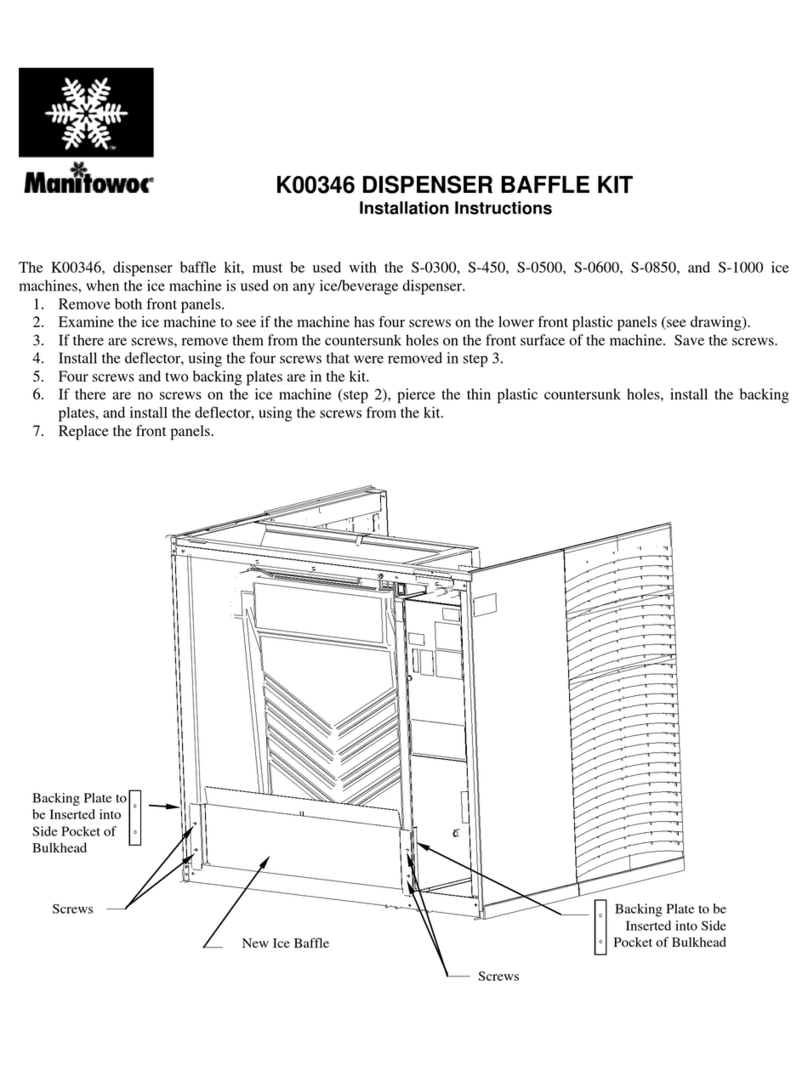
Manitowoc
Manitowoc K00346 installation instructions

AMALGAMATED INSTRUMENT
AMALGAMATED INSTRUMENT 03002V manual
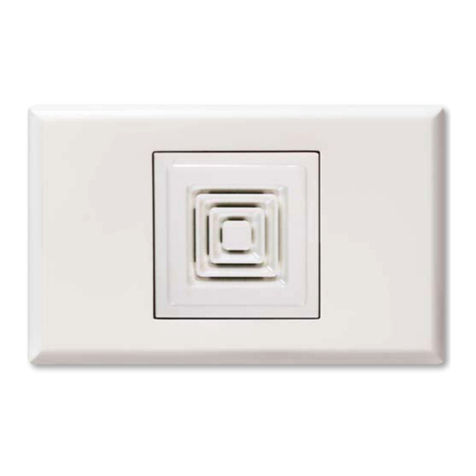
LEGRAND
LEGRAND HPM XLP917WEWE instruction manual
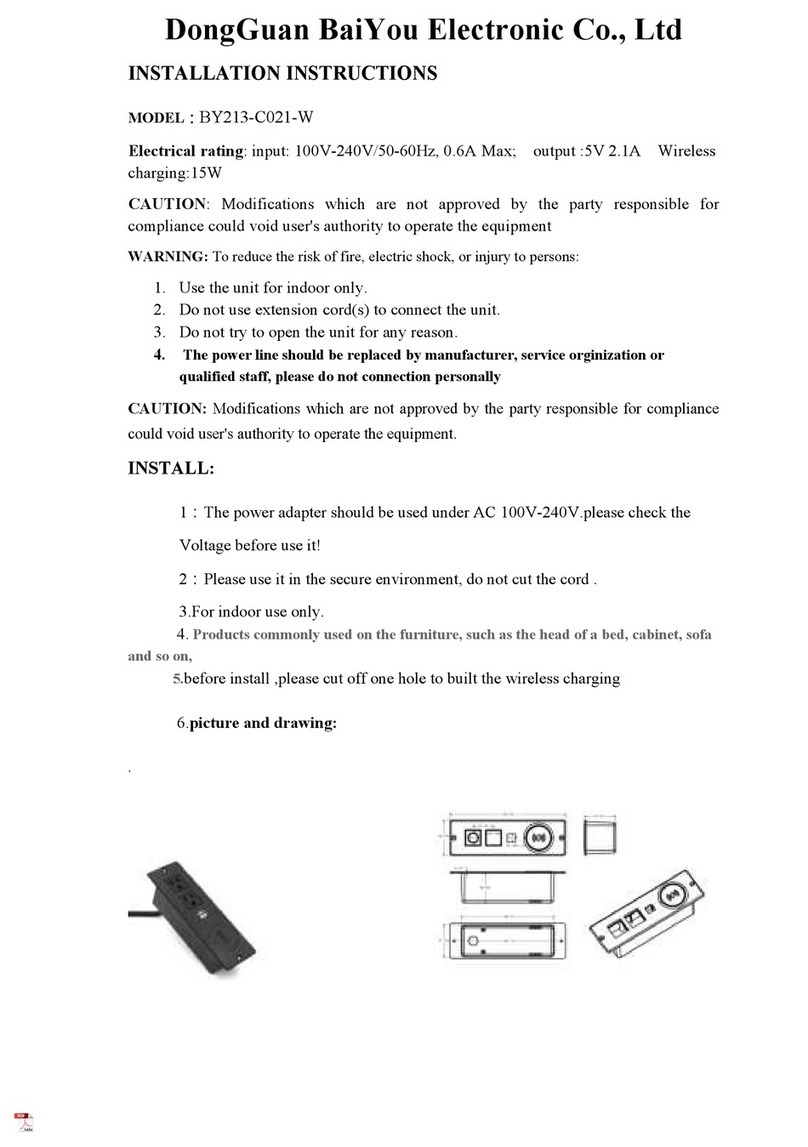
BaiYou Electronic
BaiYou Electronic BY213-C021-W installation instructions
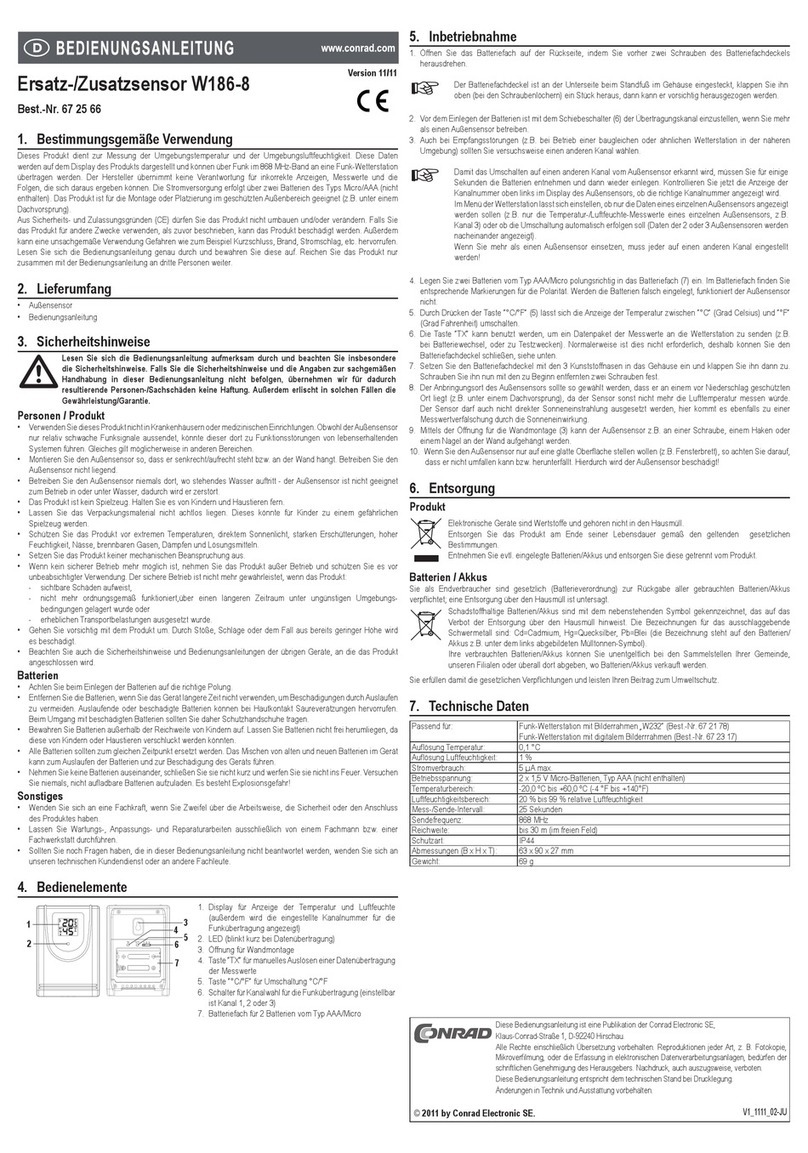
Conrad
Conrad 67 25 66 operating instructions



